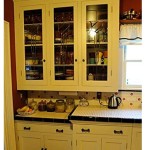Grease Remover Spray for Kitchen Cabinets: A Comprehensive Guide
Kitchen cabinets, particularly those near the stovetop, are highly susceptible to accumulating grease, grime, and cooking residue. Over time, this build-up can create a sticky, unsightly surface that not only detracts from the kitchen's aesthetics but also provides a breeding ground for bacteria and can even damage the cabinet's finish. Implementing a regular cleaning routine is essential to maintain the cleanliness and longevity of kitchen cabinets. Grease remover sprays specifically formulated for this purpose can significantly simplify and enhance the cleaning process.
Choosing the right grease remover spray involves several considerations, including the type of cabinet material, the severity of the grease build-up, and the user's preference for ingredients and application methods. Understanding the characteristics of different types of grease removers allows for informed decision-making, leading to effective and safe cleaning practices.
Understanding the Nature of Kitchen Grease
Kitchen grease is a complex mixture of fats, oils, and food particles that are aerosolized during cooking. These airborne particles settle on surfaces, including kitchen cabinets, where they gradually accumulate. Heat accelerates the decomposition of these substances, causing them to become sticky and difficult to remove. The presence of dust and other airborne contaminants further exacerbates the problem, creating a stubborn layer of grime that requires a specialized cleaning solution.
The porous nature of wood cabinets, a common material in kitchens, makes them especially susceptible to grease absorption. Unsealed or improperly sealed wood surfaces readily absorb grease, making it much more challenging to remove. Laminate and painted cabinets, while generally more resistant to grease penetration, can still accumulate a significant amount of residue over time, especially if not regularly cleaned.
Ignoring grease build-up can lead to a variety of problems. Besides the unsightly appearance and potential for bacterial growth, the accumulated grease can damage the cabinet's finish. The acidic nature of some food particles can etch into the surface, causing discoloration or even peeling of the paint or laminate. In severe cases, the grease can penetrate deep into the wood, causing permanent staining and structural damage.
Types of Grease Remover Sprays
Grease remover sprays are formulated with a variety of ingredients designed to dissolve and lift grease from surfaces. They can be broadly categorized into alkaline-based, solvent-based, and enzyme-based solutions. Each type possesses distinct characteristics and is suitable for different cleaning needs and cabinet materials.
Alkaline-based grease removers are typically formulated with strong bases such as sodium hydroxide or potassium hydroxide. These chemicals effectively saponify fats, converting them into soap-like substances that are easily rinsed away. Alkaline-based cleaners are generally very effective at removing heavy grease build-up, but they can be harsh on certain surfaces and may require careful handling. They are best suited for durable surfaces like metal and well-sealed cabinets but should be avoided on delicate finishes or unsealed wood.
Solvent-based grease removers utilize organic solvents such as mineral spirits, citrus terpenes, or isopropyl alcohol to dissolve grease. These solvents work by breaking down the molecular bonds of the grease, allowing it to be wiped away. Solvent-based cleaners are generally less harsh than alkaline-based cleaners and can be used on a wider range of surfaces. However, they may not be as effective at removing heavy grease build-up and can have a strong odor.
Enzyme-based grease removers utilize enzymes to break down fats, oils, and other organic compounds. These enzymes are biological catalysts that accelerate the decomposition process. Enzyme-based cleaners are generally considered to be the safest and most environmentally friendly option, as they are non-toxic and biodegradable. However, they may not be as effective at removing heavy grease build-up and can take longer to work than alkaline-based or solvent-based cleaners.
In addition to these main categories, some grease remover sprays may contain a combination of ingredients to provide a balance of effectiveness and safety. It is important to carefully read the product label to understand its composition and suitability for the intended application.
Factors to Consider When Choosing a Grease Remover Spray
Selecting the appropriate grease remover spray for kitchen cabinets requires careful consideration of several factors. The type of cabinet material, the severity of the grease build-up, and the user's preferences for ingredients and application methods all play a role in the decision-making process.
The type of cabinet material is a primary consideration. Wood cabinets, especially those with unsealed or porous surfaces, require gentle cleaning solutions to avoid damage. Harsh chemicals can strip the finish or penetrate the wood, causing staining or warping. Laminate and painted cabinets are generally more durable but can still be affected by abrasive cleaners or strong solvents. Always test the cleaner in an inconspicuous area before applying it to the entire surface.
The severity of the grease build-up will also influence the choice of cleaner. Light grease build-up can often be removed with mild detergents or enzyme-based cleaners. Heavy grease build-up may require a more powerful alkaline-based or solvent-based cleaner. However, it is important to use the least aggressive cleaner that effectively removes the grease to minimize the risk of damage to the cabinet finish.
User preferences for ingredients and application methods are also important factors. Some individuals may prefer natural or environmentally friendly cleaners, while others may prioritize effectiveness and speed. Some cleaners require rinsing, while others are designed to be wiped away. It is important to choose a cleaner that aligns with the user's values and cleaning habits.
Safety is paramount when using any cleaning product. Always wear gloves and eye protection to prevent skin and eye irritation. Ensure adequate ventilation when using solvent-based cleaners to avoid inhaling harmful fumes. Keep cleaning products out of the reach of children and pets. Carefully follow the manufacturer's instructions for use and disposal.
Application Techniques for Grease Remover Sprays
Proper application of a grease remover spray is essential for achieving optimal cleaning results while minimizing the risk of damage to the cabinets. Using the correct techniques ensures that the cleaner effectively dissolves the grease and grime without harming the finish.
Before applying any cleaner, it is important to prepare the surface. Remove any loose debris or dust with a dry cloth or vacuum cleaner. This will prevent the dirt from being spread around during the cleaning process and ensure that the cleaner can effectively penetrate the grease build-up.
Apply the grease remover spray directly to the affected area, following the manufacturer's instructions. Avoid oversaturating the surface, as this can cause the cleaner to drip and potentially damage surrounding areas. For stubborn grease build-up, allow the cleaner to dwell on the surface for a few minutes before wiping it away.
Use a clean, soft cloth or sponge to wipe away the dissolved grease and grime. Avoid using abrasive scrubbers, as they can scratch the cabinet finish. For textured surfaces, use a brush with soft bristles to reach into the crevices. If necessary, rinse the surface with clean water to remove any remaining residue. Dry the surface thoroughly with a clean cloth to prevent water spots.
For cabinets with intricate details or hard-to-reach areas, use a cotton swab or small brush to apply the cleaner. This will allow for precise application and prevent the cleaner from spreading to unintended areas.
After cleaning, consider applying a protective sealant or wax to the cabinets. This will help to prevent future grease build-up and make it easier to clean in the future. Choose a sealant or wax that is specifically designed for the type of cabinet material.
Regularly cleaning kitchen cabinets with a grease remover spray is crucial for maintaining their cleanliness and extending their lifespan. By understanding the nature of kitchen grease, choosing the right cleaner, and applying it using the correct techniques, individuals can effectively remove grease build-up and keep their kitchen cabinets looking their best.

Krud Kutter 1 Quart Liquid Cleaner De For Grease On Multisurfaces Kk326 The Home Depot

Homemade Grease Cleaner Spray Mom 4 Real

Kitchen Cleaner Mr Muscle

100ml All Purpose Cleaning Bubble Spray Foam Kitchen Grease Cleaner Dirt Removal

Homemade Grease Cleaner Spray Mom 4 Real

Eychin 100ml Cleaning Bubble Spray Kitchen Grease Cleaner Multifunctional Rust Remover Mousse Com

How To Deep Clean Kitchen Cabinets And Keep Them Looking Gorgeous Everyday Skate

Duzo Kitchen Power Cleaner Spray 500ml I Removes Grease Oil Tough Stain From Chimney Grill Oven Gas Stove Exhaust Fan Cabinets Wall Tiles Cleaning Nontoxic

3pack All Purpose Kitchen Bubble Cleaner Spray Household Grease Oil Removal Usa

Foam Cleaner Kitchen Grease Stain Remover Magic De Spray Home Cleaning S Temu
Related Posts








